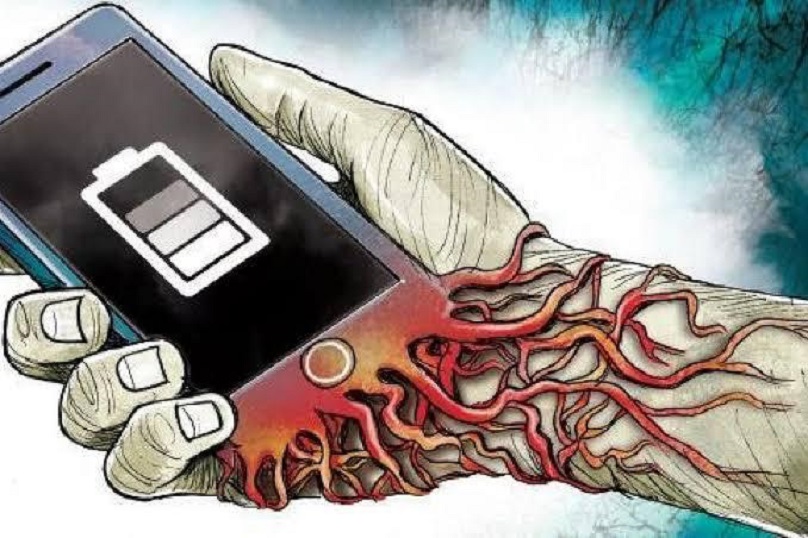The Silent Epidemic: Mobile Addiction in Kashmir
By : Javid Amin
Srinagar 13 May 2025: In the picturesque valley of Kashmir, surrounded by the majestic Himalayas and dotted with pristine lakes, a new crisis is silently engulfing its people. Mobile phone addiction has emerged as a formidable challenge, arguably more destructive than substance abuse in many ways, as it affects people across all age groups without discrimination or stigma. From teenagers in Srinagar’s bustling markets to elderly individuals in remote villages of Baramulla, from households in Anantnag to tourist spots in Gulmarg – screens have become the new reality for Kashmiris, often at the expense of the region’s rich tradition of social bonding and family connections.
A Valley Transformed
Kashmir has always been known for its tight-knit communities and strong family bonds. Traditional evening gatherings called “Wazwan” where extended families would share meals and stories, neighborhood “Masjid” gatherings, and the famous “Kehwa” tea sessions have historically formed the backbone of Kashmiri social structures. However, these cherished traditions are increasingly being replaced by the silent glow of smartphone screens.
“When I was young, our neighborhood was like one big family,” recalls Farooq Ahmad, a 65-year-old retired teacher from Sopore. “Now I see my grandchildren, my neighbors, even people my age constantly looking down at their phones. The art of conversation is dying in Kashmir.”
Marriages in Peril
Perhaps nowhere is the impact of this digital intrusion more devastating than in marital relationships. Kashmir has witnessed a troubling rise in divorce rates over the past five years, with family counselors and legal experts pointing to smartphone addiction as a significant contributing factor.
Rafiqa Bano, a family counselor working in Srinagar, shares her observations: “In the last three years alone, I’ve handled over 200 cases of marital disputes, and approximately 70% involved complaints about excessive phone usage by one or both partners. Young couples who should be building their lives together are instead living in digital isolation, even when physically present in the same room.”
One such case involves Adil and Saima (names changed), a young couple from Pulwama who separated after just two years of marriage.
“My husband would come home from work and immediately get lost in his phone,” Saima recounts, her voice trembling. “He would scroll through social media until midnight, play online games, and chat with friends. When I tried to talk to him, he would get irritated. Gradually, we stopped communicating altogether.”
Adil, when approached separately, acknowledged his excessive phone usage but defended it as his “only stress relief” from work pressures. This pattern of justification is common among addicted individuals, notes Dr. Mehraj Din, a psychiatrist at Kashmir’s premier mental health facility.
The Youth Crisis
The situation is particularly alarming among Kashmir’s youth. A recent survey conducted by Srinagar’s Institute of Mental Health and Neurosciences revealed that teenagers in the region spend an average of 7.2 hours daily on their smartphones – significantly higher than the national average of 4.8 hours.
Mohammad Ishfaq, the principal of a government school in Baramulla, shares his concerns: “We’ve banned phones in school, but it’s like fighting a losing battle. Students show withdrawal symptoms – inability to concentrate, irritability, and anxiety. Their academic performance is suffering dramatically.”
Sixteen-year-old Junaid from Anantnag represents this troubling trend. Once a bright student with promising cricket skills, he now struggles academically and has abandoned sports altogether.
“I know I’m addicted,” he admits candidly. “I try to study but end up checking Instagram or playing PUBG. My parents have tried everything – counseling, restrictions, even confiscating my phone – but I always find a way back to it.”
A Cultural Shift
The impact extends beyond individual homes to Kashmir’s cultural fabric. Bashir Ahmed Dar, a cultural activist from Srinagar, laments: “Our traditional arts, crafts, and storytelling traditions thrived on person-to-person interaction. Today’s generation neither has the patience nor the interest to learn these arts. They would rather watch a two-minute video on their phones than spend an hour learning a traditional craft.”
The region’s famous handicrafts industry – from Pashmina shawls to Walnut wood carving – is facing an unprecedented shortage of young apprentices willing to learn these time-intensive skills. Instead, young Kashmiris are increasingly drawn to quick digital fame and instant gratification.
The Psychological Impact
Mental health professionals in Kashmir are reporting alarming trends. Dr. Arshad Hussain, a leading psychiatrist in the valley, notes: “We’re seeing a significant rise in conditions directly linked to excessive phone usage – anxiety disorders, depression, sleep disturbances, and what we call ‘phantom vibration syndrome’ where people feel their phone vibrating even when it isn’t.”
The problem is compounded by Kashmir’s unique political situation. “During periods of internet shutdowns, we witness severe withdrawal symptoms in many patients,” Dr. Hussain continues. “This paradoxically confirms how deep the addiction runs – the absence of connectivity causes genuine psychological distress.”
Real Stories from the Valley
Zahid and Nuzhat (names changed), once considered an ideal couple in their Srinagar neighborhood, recently separated after seven years of marriage. Their story reflects a common pattern.
“It started innocently,” Nuzhat explains. “Zahid would bring work home on his phone. Then came social media, then online gaming. Eventually, he was physically present but mentally absent. When our child fell ill one night, I couldn’t even get his attention because he was so engrossed in his phone.”
In another case from South Kashmir’s Shopian district, 72-year-old Ghulam Mohammad speaks with visible pain about his family: “I have three sons, all living in the same house with their families. Yet, I spend most evenings alone. Everyone – my sons, their wives, even my grandchildren – is busy with their phones. Our traditional family dinners have become silent affairs with everyone scrolling through their devices.”
The Economic Factor
Ironically, economic factors have contributed to this crisis. Kashmir has witnessed rapid smartphone penetration due to falling device prices and cheaper internet plans, especially after the introduction of certain telecom services that dramatically reduced data costs.
“In 2015, barely 30% of my students had smartphones. Today, it’s nearly 100%,” notes Ishrat Jabeen, who teaches at a college in Anantnag. “The problem isn’t access to technology, which can be beneficial, but the lack of digital literacy and self-regulation.”
Seeking Solutions
Amidst this growing crisis, some community initiatives offer hope. The “Digital Detox Kashmir” movement, started by a group of concerned teachers and health professionals, organizes phone-free community events and workshops on healthy digital habits.
Some religious leaders have also stepped in. Several mosques in Srinagar and other districts have started campaigns emphasizing moderate technology use, citing Islamic principles of balanced living.
Psychologist Aaliya Shafi has pioneered a counseling program specifically for phone-addicted couples. “We don’t demonize technology,” she explains. “Instead, we help couples establish healthy boundaries and rediscover the joy of direct human connection.”
Her program includes mandatory “phone-free hours” at home, joint activities that don’t involve screens, and communication exercises. “The results are encouraging,” she reports. “About 60% of couples show significant improvement in their relationships within three months.”
The Way Forward
As Kashmir grapples with this modern epidemic, experts suggest a multi-pronged approach:
- Community awareness programs about the signs and consequences of phone addiction
- School-based digital literacy curricula that emphasize responsible usage
- Family-centered interventions that create healthy tech boundaries at home
- Revival of traditional community activities that encourage face-to-face interaction
- Professional counseling resources specifically addressing technology addiction
“This isn’t about rejecting technology,” emphasizes Dr. Mehraj Din. “It’s about reclaiming control over technology rather than letting it control us. Kashmir’s strong community traditions actually give us an advantage in tackling this problem collectively.”
For a region that has weathered numerous storms throughout its history, the challenge of mobile addiction presents a different kind of test – one that threatens not just individual well-being but the very social fabric that has sustained Kashmiris through difficult times.
As the sun sets over Dal Lake and the call to prayer echoes across the valley, the gentle ping of notifications continues to interrupt conversations in homes across Kashmir. The battle between screens and human connection continues – and its outcome will shape the future of this beautiful but troubled region.
This article is based on interviews and observations from across Kashmir’s districts. Some names have been changed to protect privacy.


